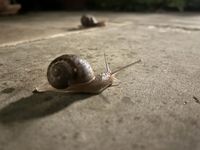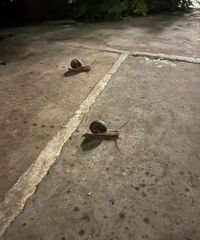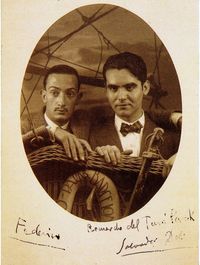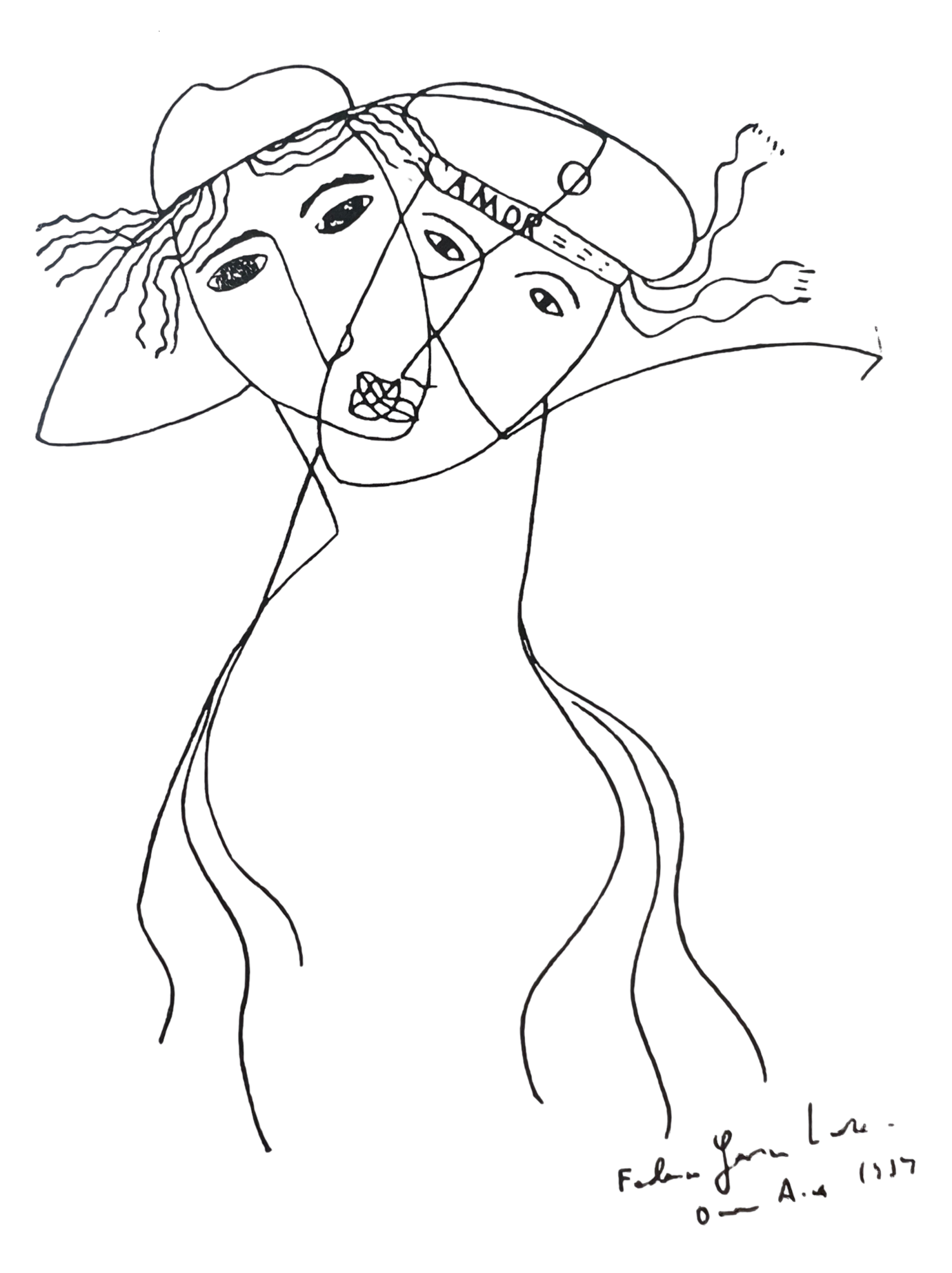"And the snail, the peaceful bourgeois of the narrow trail, contemplates the landscape. The divine serenity of Nature."
Even in the context of the animal kingdom - a collective of bizarre and sublime creatures - the snail is surreal. A shelled creature, wholly unto itself (though it must over-winter in mud), who has diverged enough from its ancestors to move by its own means. Not in the water, but on land. The snail is the apex of gastropods; oysters wish they had its agility, and cockles envy its anti-friction salivation.
Poets have long opined on the inner workings of this creature, like Marianne Moore's "To a Snail," written in 1924, which celebrates the snail's "occipital horn."
If “compression is the first grace of style,”
you have it. Contractility is a virtue
as modesty is a virtue.
It is not the acquisition of any one thing
that is able to adorn,
or the incidental quality that occurs
as a concomitant of something well said,
that we value in style,
but the principle that is hid:
in the absence of feet, “a method of conclusions”;
“a knowledge of principles,”
in the curious phenomenon of your occipital horn.
From Marianne Moore's "To a Snail"
 Photograph by Ellen Vrana.
Photograph by Ellen Vrana.At night, garden snails exit their lairs and begin their epic migration across the stone slabs to eat. It is slow, undeterred, and consistent. I like spending time with snails. I imagine their inner monologues. They hum bluegrass and dream of soft shoots.
The snail is so resoundingly peculiar and unassuming that we efficiently use it for metaphor and motif. When Spanish surrealist poet Federico del Sagrado Corazón de Jesús García Lorca (June 5, 1898 - August 19, 1936) used snails as protagonists in his 1919 dramatic poem, "Encounters of an Adventurous Snail," it felt entirely real. García Lorca's snails are innocent and curious, conventional and developing wisdom. What else but a snail to illustrate the young hope thrown against an indifferent world?
There is a childlike sweetness
in the still morning.
The trees stretch
their arms to the earth.
A tremulous vapor
blankets the seed-beds,
and the spiders unfurl
their silken roads
- rigging streaks upon the pure crystal of the air.
The divine serenity
of Nature
gave him courage and faith,
and, forgetting the troubles
of his home, he longed
to see the end of the path.
García Lorca was born in Andalusia, southern Spain. When he was nearly twenty, he left his native Grenada and a job as a lawyer to become a poet full-time in Madrid. Through support from the artistic community, especially surrealists like Dali and filmmaker Luis Buñuel, García Lorca published his first poetry collection, Libro de Poemas, which was a success. He wrote Encounters of an Adventurous Snail the year before he left for Madrid.
Does the poet imagine himself as the snail, galvanizing his "child-like sweetness" into courage?
The divine serenity
of Nature
gave him courage and faith,
and, forgetting the troubles
of his home, he longed
to see the end of the path.
Along his "path," García Lorca's snail gets waylaid by predatory - albeit disillusioned - frogs who are "listless and sickly."
'those modern songs,'
one of them muttered,
are useless.' 'Absolutely,
my friend,' replied
the other frog, who was
maimed and almost blind.'
'When I was young I believed
that, in the end, if God heard
our singing. He would have
mercy. But the knowledge
I have gained in my long life
makes me disbelieve it.
I no longer sing...'
 Photograph by Ellen Vrana.
Photograph by Ellen Vrana.The snails continue, fearing the frogs and wanting to return home. However, his more jaded garden inhabitants remind him that there is no eternal peace. A set of industrious, judicious ants confirms this truth. Now a bit terrified, the innocent snail feels despondent that his short, hopeful voyage was not what he imagined.
The snail sighs
and departs, bewildered,
full of confusion
regarding the eternal. 'The path
has no end,' he exclaims.
'Perhaps one could reach
the stars from here.
But my lowly dullness
will hinder my arrival.'
After the success of his first publication, García Lorca revisited the snail motif - possibly the same character, matured - in The Dialogue of Two Snails. The snail (now there are two of them) is again part of a simple, bucolic scene. But instead of harboring hopes and dreams, he is focused on one desired end: reaching the top of the fennel stalk.
White Snail.- (Silence.)
(A young lady with a lace parasol comes alone counting her steps. Upon reaching a little brook, she hesitates. Then she jumps.)
Black Snail.- (Silence.)
(The rat has crossed the river. The bad rat. The rat that devours the tender rootlets.)
White Snail.- (Silence.)
(The young lady consults the scent of the fennel beds. The evening, lacking intelligent relations crumbles down into the haze of the horizon.)
Black Snail.- (Silence.)
(The rat returns to the blackberry bushes. An obscure voice delights in pronouncing this word: blackberry, blackberry, blackberry.)
White Snail.- (Pause.)
(The young lady sits down on the green hillside. She has come outside alone because she does not recall the mice.)
Black Snail.- (Dumbstruck.) (Silence.)
(In the watery cove, with nary a crease, a long cloud quivers in place. The rat heads for it like a bird. The Lord must have consented to his inflicting this abuse.)
White Snail.- (Silence.)
(No one likes the book the young lady is reading. She is silly, unaware that her mountains of sugar are full of ants.)
Black Snail.- (Exit.)
White Snail.- (At the top of the fennel stalk.)
Ay!
In 1928 García Lorca published Gypsy Ballads, poetry that connected his love for music, his fascination with Spain's gypsy peoples, and Andalucian culture. At this point, he had an emotionally intimate friendship with Salvador Dalí, but the two fell out when García Lorca's sexual infatuation with the painter was unreturned.
 Salvador Dalí and Federico García Lorca in 1925.
Salvador Dalí and Federico García Lorca in 1925.By the early 1930s, Spain was split into multiple political, religious, and economic factions, including a nationalist party that would soon run the country for decades under Generalissimo Franco's fascist rule. García Lorca was publishing dramatic works, avant-garde sketches and plays, and living privately as a homosexual.
In August 1936, García Lorca and his brother-in-law, who was then Mayor of Granada, were arrested in García Lorca's hometown and executed by firing squad two days later. It remains unknown who exactly killed García Lorca and why but the speculation centers on his homosexuality and socialist political affiliations. His body was never found.
The "Encounters of an Adventurous Snail" ends in the environment it began; the snail is changed but not undone.
All was hazy
in the feeble sunlight and fog.
Distant belfries
summon people to church,
and the snail, the peaceful
bourgeois of the narrow trail,
bewildered and uneasy,
contemplates the landscape.
 Illustration by Federico García Lorca.
Illustration by Federico García Lorca.From the beginning of his writing career, García Lorca explored the duality of life and death, hope and disillusionment. As early as twenty, he was writing about death and beauty; my favorite, "The Moon and Death," includes lines like "The moon has teeth of ivory" that "purchased paints from Death's prismatic greys."
García Lorca suffered from depression throughout his life, but it intensified after his friendship with Dali and Luis Buñuel ended. Like John Keats, another depressive who died young, García Lorca transcended the highs and lows of his inner turmoil through artistic creation and search for emotion and beauty. What might he have produced had he not been murdered?
When someone gifts us insight so profound it should be canonized, and also dies absurdly young, like Arthur Rimbaud, Simone Weil, or Martin Luther King Jr., their death becomes part of their narrative. When such an artist dies young in an inconceivably unjust way like García Lorca, that artist's life, life's work, and death are inseparable. Which, in this case, is oddly fitting.

